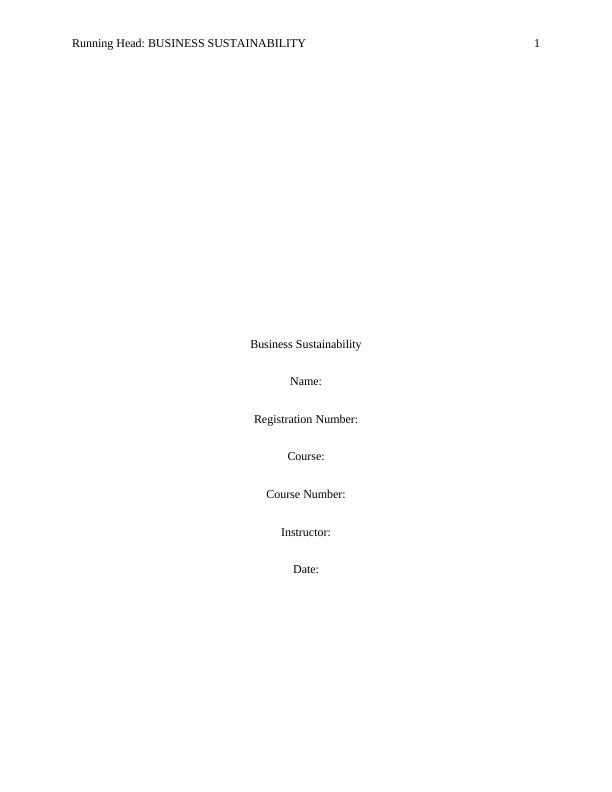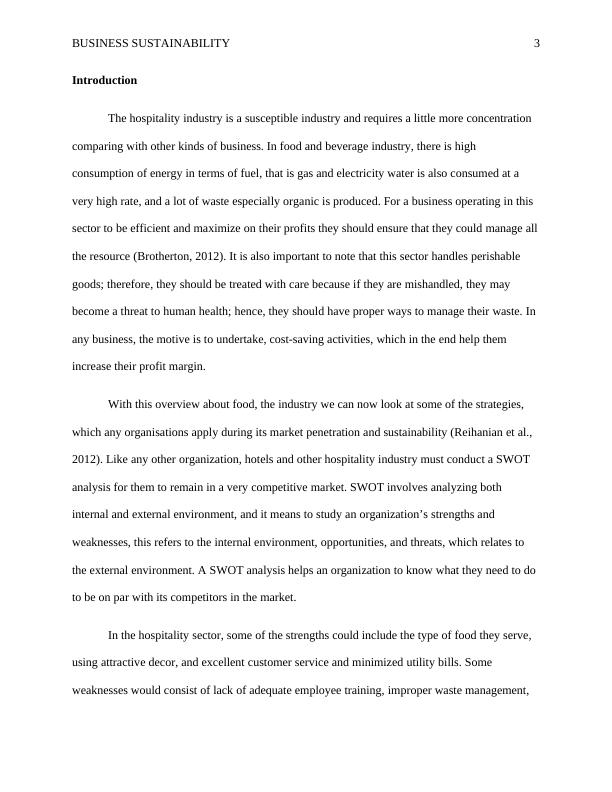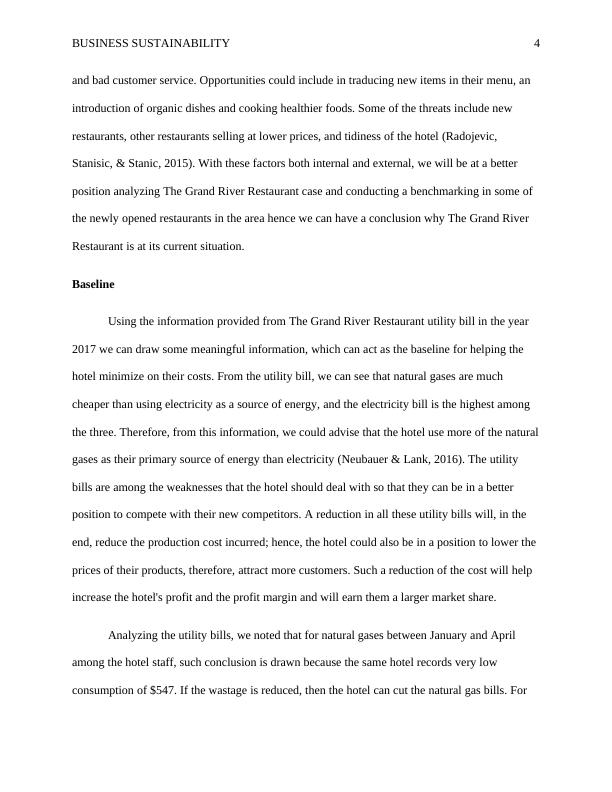Business Sustainability
Added on 2023-04-10
13 Pages3003 Words362 Views
Running Head: BUSINESS SUSTAINABILITY 1
Business Sustainability
Name:
Registration Number:
Course:
Course Number:
Instructor:
Date:
Business Sustainability
Name:
Registration Number:
Course:
Course Number:
Instructor:
Date:

BUSINESS SUSTAINABILITY 2
Executive Summary
In this report, we had a brief overview of the hospitality industry; during the research, we
found out that there is high consumption of energy in this industry especially in terms of fuel,
maybe gas, or electricity. However, we noted that this energy consumption could be reduced to
reduce the production cost so that a hotel can maximize their profits. Some of the
recommendable ways to reduce the high consumption include using more of natural gases than
electricity as a source of energy, using solar systems, digging boreholes, always ensure no
machine is on while not in use, using more heat absorbent utensils and reducing wastage within
the hotel. We also recommended ways on how the hotel would be able to handle their waste
correctly, we suggested that they train their staff on separating organic and inorganic waste,
practice proper waste disposal and revising their contract with their service provider so that they
can rectify any terms they feel are bringing up restrictions or disadvantages. In the comparison
section, comparing the notes from each group member, there was an analysis of different
restaurant in the same area. Although there has been a reduction in sales in the hotel, we still
believe that the hotel can still be sustainable in its business and remain relevant in the market but
for them to succeed they have to undertake and consider some of the recommendations given in
this report.
Executive Summary
In this report, we had a brief overview of the hospitality industry; during the research, we
found out that there is high consumption of energy in this industry especially in terms of fuel,
maybe gas, or electricity. However, we noted that this energy consumption could be reduced to
reduce the production cost so that a hotel can maximize their profits. Some of the
recommendable ways to reduce the high consumption include using more of natural gases than
electricity as a source of energy, using solar systems, digging boreholes, always ensure no
machine is on while not in use, using more heat absorbent utensils and reducing wastage within
the hotel. We also recommended ways on how the hotel would be able to handle their waste
correctly, we suggested that they train their staff on separating organic and inorganic waste,
practice proper waste disposal and revising their contract with their service provider so that they
can rectify any terms they feel are bringing up restrictions or disadvantages. In the comparison
section, comparing the notes from each group member, there was an analysis of different
restaurant in the same area. Although there has been a reduction in sales in the hotel, we still
believe that the hotel can still be sustainable in its business and remain relevant in the market but
for them to succeed they have to undertake and consider some of the recommendations given in
this report.

BUSINESS SUSTAINABILITY 3
Introduction
The hospitality industry is a susceptible industry and requires a little more concentration
comparing with other kinds of business. In food and beverage industry, there is high
consumption of energy in terms of fuel, that is gas and electricity water is also consumed at a
very high rate, and a lot of waste especially organic is produced. For a business operating in this
sector to be efficient and maximize on their profits they should ensure that they could manage all
the resource (Brotherton, 2012). It is also important to note that this sector handles perishable
goods; therefore, they should be treated with care because if they are mishandled, they may
become a threat to human health; hence, they should have proper ways to manage their waste. In
any business, the motive is to undertake, cost-saving activities, which in the end help them
increase their profit margin.
With this overview about food, the industry we can now look at some of the strategies,
which any organisations apply during its market penetration and sustainability (Reihanian et al.,
2012). Like any other organization, hotels and other hospitality industry must conduct a SWOT
analysis for them to remain in a very competitive market. SWOT involves analyzing both
internal and external environment, and it means to study an organization’s strengths and
weaknesses, this refers to the internal environment, opportunities, and threats, which relates to
the external environment. A SWOT analysis helps an organization to know what they need to do
to be on par with its competitors in the market.
In the hospitality sector, some of the strengths could include the type of food they serve,
using attractive decor, and excellent customer service and minimized utility bills. Some
weaknesses would consist of lack of adequate employee training, improper waste management,
Introduction
The hospitality industry is a susceptible industry and requires a little more concentration
comparing with other kinds of business. In food and beverage industry, there is high
consumption of energy in terms of fuel, that is gas and electricity water is also consumed at a
very high rate, and a lot of waste especially organic is produced. For a business operating in this
sector to be efficient and maximize on their profits they should ensure that they could manage all
the resource (Brotherton, 2012). It is also important to note that this sector handles perishable
goods; therefore, they should be treated with care because if they are mishandled, they may
become a threat to human health; hence, they should have proper ways to manage their waste. In
any business, the motive is to undertake, cost-saving activities, which in the end help them
increase their profit margin.
With this overview about food, the industry we can now look at some of the strategies,
which any organisations apply during its market penetration and sustainability (Reihanian et al.,
2012). Like any other organization, hotels and other hospitality industry must conduct a SWOT
analysis for them to remain in a very competitive market. SWOT involves analyzing both
internal and external environment, and it means to study an organization’s strengths and
weaknesses, this refers to the internal environment, opportunities, and threats, which relates to
the external environment. A SWOT analysis helps an organization to know what they need to do
to be on par with its competitors in the market.
In the hospitality sector, some of the strengths could include the type of food they serve,
using attractive decor, and excellent customer service and minimized utility bills. Some
weaknesses would consist of lack of adequate employee training, improper waste management,

BUSINESS SUSTAINABILITY 4
and bad customer service. Opportunities could include in traducing new items in their menu, an
introduction of organic dishes and cooking healthier foods. Some of the threats include new
restaurants, other restaurants selling at lower prices, and tidiness of the hotel (Radojevic,
Stanisic, & Stanic, 2015). With these factors both internal and external, we will be at a better
position analyzing The Grand River Restaurant case and conducting a benchmarking in some of
the newly opened restaurants in the area hence we can have a conclusion why The Grand River
Restaurant is at its current situation.
Baseline
Using the information provided from The Grand River Restaurant utility bill in the year
2017 we can draw some meaningful information, which can act as the baseline for helping the
hotel minimize on their costs. From the utility bill, we can see that natural gases are much
cheaper than using electricity as a source of energy, and the electricity bill is the highest among
the three. Therefore, from this information, we could advise that the hotel use more of the natural
gases as their primary source of energy than electricity (Neubauer & Lank, 2016). The utility
bills are among the weaknesses that the hotel should deal with so that they can be in a better
position to compete with their new competitors. A reduction in all these utility bills will, in the
end, reduce the production cost incurred; hence, the hotel could also be in a position to lower the
prices of their products, therefore, attract more customers. Such a reduction of the cost will help
increase the hotel's profit and the profit margin and will earn them a larger market share.
Analyzing the utility bills, we noted that for natural gases between January and April
among the hotel staff, such conclusion is drawn because the same hotel records very low
consumption of $547. If the wastage is reduced, then the hotel can cut the natural gas bills. For
and bad customer service. Opportunities could include in traducing new items in their menu, an
introduction of organic dishes and cooking healthier foods. Some of the threats include new
restaurants, other restaurants selling at lower prices, and tidiness of the hotel (Radojevic,
Stanisic, & Stanic, 2015). With these factors both internal and external, we will be at a better
position analyzing The Grand River Restaurant case and conducting a benchmarking in some of
the newly opened restaurants in the area hence we can have a conclusion why The Grand River
Restaurant is at its current situation.
Baseline
Using the information provided from The Grand River Restaurant utility bill in the year
2017 we can draw some meaningful information, which can act as the baseline for helping the
hotel minimize on their costs. From the utility bill, we can see that natural gases are much
cheaper than using electricity as a source of energy, and the electricity bill is the highest among
the three. Therefore, from this information, we could advise that the hotel use more of the natural
gases as their primary source of energy than electricity (Neubauer & Lank, 2016). The utility
bills are among the weaknesses that the hotel should deal with so that they can be in a better
position to compete with their new competitors. A reduction in all these utility bills will, in the
end, reduce the production cost incurred; hence, the hotel could also be in a position to lower the
prices of their products, therefore, attract more customers. Such a reduction of the cost will help
increase the hotel's profit and the profit margin and will earn them a larger market share.
Analyzing the utility bills, we noted that for natural gases between January and April
among the hotel staff, such conclusion is drawn because the same hotel records very low
consumption of $547. If the wastage is reduced, then the hotel can cut the natural gas bills. For

End of preview
Want to access all the pages? Upload your documents or become a member.
Related Documents
Sustainability in Hospitality Managementlg...
|12
|3520
|22
Sustainability Hospitality Management : Assignmentlg...
|11
|3300
|84
Food Waste Management: Challenges and Solutionslg...
|5
|1464
|272
Generation of Bio-energy from waste for power production and sustainable heat Generationlg...
|9
|1727
|411
Sustainable Hospitality: Issues, Impact, and Managementlg...
|10
|3178
|342
Policy and Planning for Sustainable Developmentlg...
|14
|3002
|289
